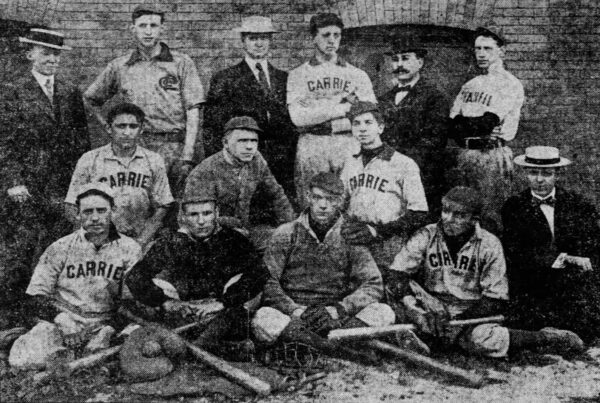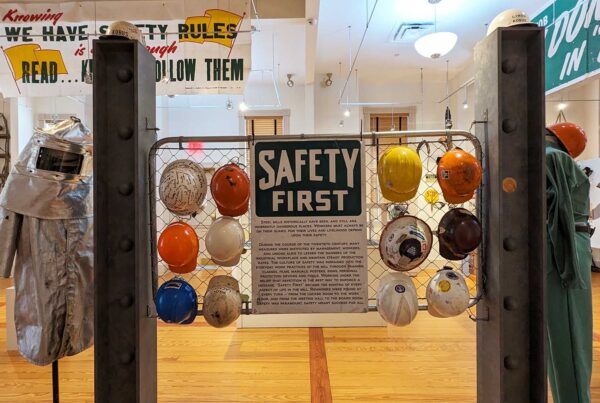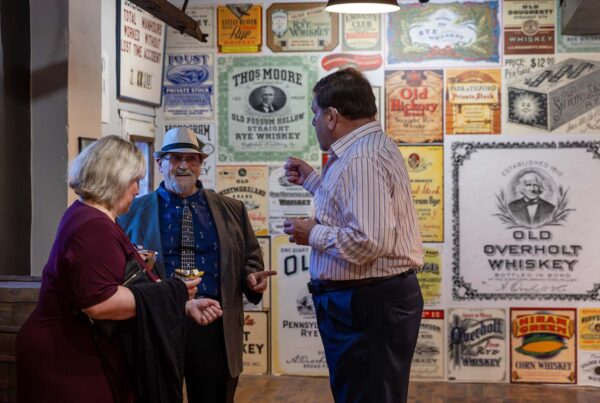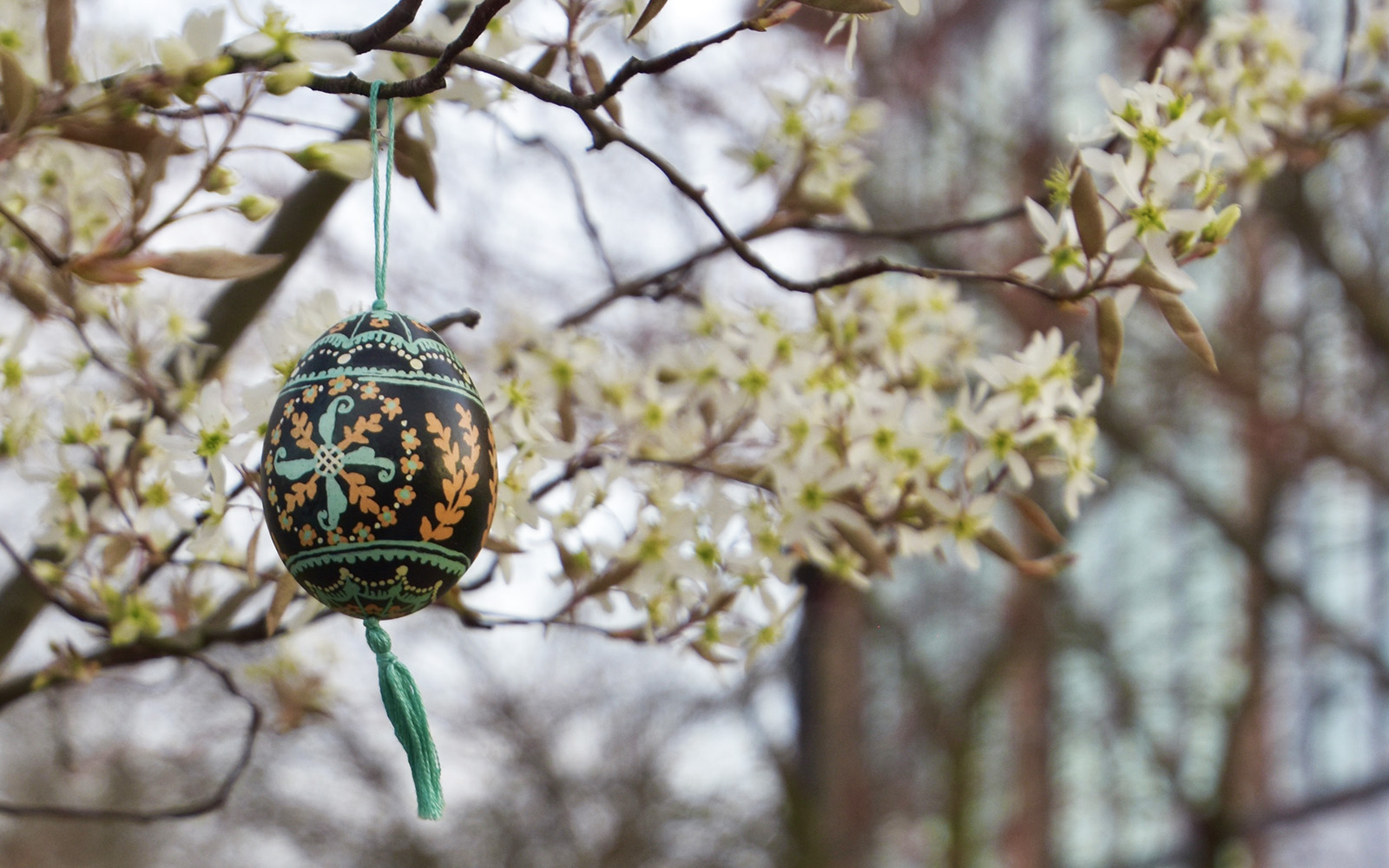
By Brianna Horan, Manager of Tourism & Visitor Experience | Image of a pysanky egg created and photographed by Lisa DiStefano-Bauer
 Traditions in a Time of Social Distancing
Traditions in a Time of Social Distancing
Flowering trees, fragrant bulbs, chirping birds, and warmer weather are very real expressions of spring’s arrival, but to prevent the spread of COVID-19 our usual celebrations of the season are encouraged to be virtual this year. Even though some people have used their extra time indoors to spring clean like they’ve never spring cleaned before, health experts advise that no one who’s not already living in your home should visit to see how organized you’ve become. This also means tables at Passover Seder and Easter brunch could feel empty in coming week, and the iftars of Ramadan towards the end of the month may be more solitary breakings of fast.
With the need to be physically distant, this year’s springtime celebrations are going to be different. Dan Rather shared that he carried a potted plant around his apartment on Palm Sunday in the closest approximation to a palm frond processional that he could manage at home. The Wall Street Journal answers some new questions that may arise as loved ones share Seder via videochat, in addition to the traditional Four Questions that prompt the story of the exodus from Egypt. And – never one to be out done – Martha Stewart imagines three ways to host a virtual Easter egg hunt on Sunday.
Some of the circumstances surrounding this year’s celebrations aren’t dissimilar from those that immigrants arriving in our region would have faced. We’re separated by distance from the people we love. We’re making do with the what we have on hand. And the holidays have the potential to be a bright spot of faith in a time of stress and uncertainty. Just as embracing traditions and ethnic customs have given immigrants a steadfast sense of connection to the places and people they’ve left behind, the rituals that we repeat this year can help us feel close to people we can’t be with. Even if they have to be tweaked in the name of good health, the preparations that we make, the blessings that we pray, the recipes we follow, and the ways we celebrate remind us of the spirit of the holiday and those who we would like to be sharing it with.
If you find yourself wanting to tap into the kinds of authentic ethnic cuisine and folk crafts that have been passed down from generation to generation, below is a collection of recipes and customs with strong immigrant roots. These recipes are from a cookbook published in 1993 called Out of This Kitchen: A History of the Ethnic Groups and their Foods in the Steel Valley. They come from the kinds of kitchens where measuring cups were rarely used, but nothing was wasted. Often the home cook who submitted the recipe also included a memory or serving suggestion for a dose of extra nostalgia.
If you’re not finding a specific ingredient in your pantry right now, this list of ingredient substitutions from Joy of Baking might be helpful, and NuRoots has suggestions for reimagining the usual symbolic foods and objects that are essential for a Seder plate. And if you’d like to honor the past and support local businesses at the same time, a list of pick-up and delivery options is also included.
Rivers of Steel hopes that you and your loved ones enjoy a safe, healthy, and joyful spring holiday this year.
Jewish
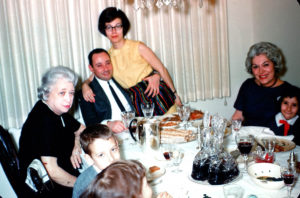 Passover is a Jewish holiday that commemorates the emancipation of the Israelites from decades of slavery in ancient Egypt. When Pharoah refused to comply to God’s requests to free the Israelites, ten devastating plagues were delivered upon Egypt. The last of these ten plagues was to kill the firstborn of all Egyptians, but while doing so God spared the children of Israel, “passing over” their homes. This last plague broke Pharoah’s resistance, and he chased his former slaves out of his land. The Israelites left in such a hurry that the bread they baked as provisions for the journey did not have time to rise.
Passover is a Jewish holiday that commemorates the emancipation of the Israelites from decades of slavery in ancient Egypt. When Pharoah refused to comply to God’s requests to free the Israelites, ten devastating plagues were delivered upon Egypt. The last of these ten plagues was to kill the firstborn of all Egyptians, but while doing so God spared the children of Israel, “passing over” their homes. This last plague broke Pharoah’s resistance, and he chased his former slaves out of his land. The Israelites left in such a hurry that the bread they baked as provisions for the journey did not have time to rise.
Today Jews celebrate Passover every year in early spring to remember that Exodus, when Jews trekked from Egypt to Mount Sinai, by abstaining from any food that contains leavening agents called chametz – like wheat, barley, rye, oats, or spelt – during the eight-day holiday. All chametz must be removed from the house, or sold to a non-Jew before Passover begins. Jews are allowed to buy back their leavened items when the holiday is over.
Central Passover are two symbolic dinners, called Seders, the first two nights of Passover. Items that are always served during these meals include matzah (flat, unleavened bread), bitter herbs, and four cups of wine or grape juice. The recitation of the Haggadah, a detailed description of the story of the Exodus from Egypt, is the focal point of every Seder, and it ensures that future generations know this integral part of Jewish heritage. A child at the table asks the traditional “Four Questions” to prompt the story from the host of the Seder.
The Out of this Kitchen cookbook includes the recipes below, which would work nicely at a Passover Seder. These recipes were submitted without attribution. If you plan to reach out to your Jewish friends and loved ones celebrating Passover, you can greet them by saying, “chag Pesach samekh” – which translates to “happy Passover holiday” in Hebrew.
Gefilte Fish, Russian Style
6 lbs. carp or pike, ground
Salt
1 lb. onions, finely chopped
3 egg yolks, beaten
3 egg whites, whipped
½ cup matzo meal
2 Tbsp. oil
Salt and pepper to taste
1 lb. carrots, thinly sliced
3 lbs. beets, thinly sliced
4 large Spanish onions, thinly sliced
Cold water to cover
Cut whole fish into 2” slices. Carefully remove flesh without breaking skin and bones. Salt the skins and bones and place in bowl while preparing filling. Grind or process the flesh to a coarse consistency, like ground meat. Mix together ground fish and onions. Add eggs (yolks and whites), matzo meal, oil and salt and pepper. Mix thoroughly. Wet hands with cold water. Form oval fish patties and fit them into the fish skins.
Place head and any other bones in the bottom of a deep heavy pot. Add enough carrots, beets and onions to cover bottom of pot. Lay wrapped patties on top of vegetables. Separate each patty with a sliced beet. Keep alternating vegetable layers with fish patty layers. Add cold water seasoned with salt and pepper to cover. Cover pan and bring to a quick boil. Reduce heat and simmer 1 ½ hours covered. Cook 1 more hour without lid. Cool. Carefully remove patties and place on a platter. Garnish with cooked vegetables. Refrigerate. Serve with horseradish. Makes 8 to 10 servings.
Carrot Tsimes and Knadel
Tsimes is a sweet vegetable and meat stew, and Knadel is Yiddish for matzah ball.
Tsimes
½ lb. brisket of beef
1 onion, small
1 tsp. salt
2 cups water
2 lbs. carrots, diced
½ cup sugar
Put brisket, onion and salt in water. Bring to a boil. Lower heat, cover and simmer for 1 hour. Add the carrots and the sugar. Cook until carrots are tender, about 20 to 30 minutes.
Knadel
2 medium potatoes, grated
1 Tbsp. matzo meal
1 ½ Tbsp. chicken broth
1 Tbsp. onion, grated
½ tsp. salt
¼ tsp. black pepper
Drain the grated potatoes. Remove excess moisture by draining thoroughly. Add rest of ingredients and spread over the top of the tsimes. Place in baking dish and bake at 350° for about 20 minutes until slightly browned. Serves 6.
Orange and Lemon Kezel
1 large orange
1 large lemon
4 eggs
2/3 cup sugar
4 Tbsp. matzo meal
½ cup chopped nuts, optional
Bring fruit (left whole) to a boil in water. Pour off water and refill pan with water. Bring to another boil and pour off water again. Add fresh water a third time and boil until fruit is tender. Drain. Open fruit and allow to cool. Remove seeds. Mash fruit and pulp. Set aside. Beat the eggs, sugar and matzo meal until foamy. Add fruit pulp. Add nuts, if desired. Bake 50 minutes at 325°.
German
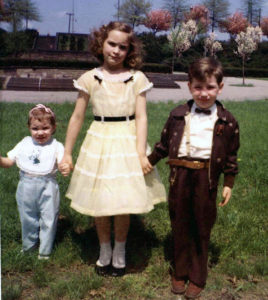 Children have German immigrants to thank for bringing their tradition of the Easter Bunny with them to America. Their children made nests where an egg-laying hare called “Osterhase” or “Oschter Haws” would lay its colored eggs. The custom eventually spread across the United States, and baskets took the place of nests.
Children have German immigrants to thank for bringing their tradition of the Easter Bunny with them to America. Their children made nests where an egg-laying hare called “Osterhase” or “Oschter Haws” would lay its colored eggs. The custom eventually spread across the United States, and baskets took the place of nests.
The colorful egg trees that adorn front lawns in the spring also take root in German tradition, where they’re known as an Osterbaum (Easter Tree). The German Girl in America blog has a number of suggestions for making your own fanciful eggs – either blown out, decoupaged, or colored in the Sorbian style. Be sure to check out the photo of Volker Kraft’s Osterbaum in Saalfeld, Germany – he and his family have more than 10,000 eggs on their tree.
Germans celebrate Easter for four days, starting on Maundy Thursday and ending on Easter Monday. GermanFoods.org has a collection of Easter recipes ranging from Seven Herb Soup to Brandenburg Lamb.
For Kaffee und Kuchen (Coffee and Cake) on Easter Sunday afternoon, you might want to try the recipe below for Napf Kuchen, a German Coffee Cake recipe shared by Dolores Zewe of Duquesne in the cookbook Out of this Kitchen. The recipe has been in the Zewe family for more than 60 years.
Napf Kuchen | German Coffee Cake
1 ½ sticks butter or margarine
1 ¼ cups sugar
2 eggs
2 cups flour
1 tsp. baking powder
½ tsp. baking soda
½ pint sour cream
1 tsp. vanilla
2 Tbsp. sugar
1 tsp. cinnamon
Chopped nuts
Raisins
Powdered sugar
Preheat oven to 350°. Grease and flour a Bundt, angel food or Jell-O mold pan. Mix and cream margarine or butter, sugar, eggs and beat until fluffy. Sift together flour, baking powder and baking soda; add to creamed mixture. Fold in sour cream and vanilla. Pour half the batter in prepared pan. Mix together 2 Tbsp. sugar, cinnamon, as many chopped nuts and raisins as desired. Sprinkle over batter in pan. Pour remaining batter over all. Bake 45-50 minutes. Let cool 10 minutes before turning out of pan. Sprinkle with powdered sugar.
Scotch-Irish & Irish
After abstaining from meat for the 40 days of Lent, main dishes of lamb or ham were a much anticipated part of Easter dinner. These vegetable dishes from Out of this Kitchen would make nice springtime accompaniments. The homecook who submitted them is unattributed, but a cooking tip from the December 15, 1893, issue of the Homestead Local News is included:
“The water in which green peas has been boiled should not be thrown away. It has a fine flavor – the very essence of peas. A little stock added, seasoned to taste, makes an economical, delicious wholesome and appetizing soup.
Glazed Carrots with Onions
1 lb. carrots, cut into bite-sized pieces
5 onions, sliced
¼ cup butter
Brown sugar (to thicken)
Dash of lemon juice
Dash of corn starch
Dash of water
In salted water, just enough to cover the vegetables, bring to a boil for 1 minute, reduce heat, cover and simmer until tender. Drain. In another pan, combine the butter and sugar and stir. Add the lemon juice, cornstarch, water and stir. Cook over low heat until thickened. Pour over vegetables, toss and cook until golden brown. Serve warm. Serves 6 to 8.
New Peas with Fresh Mint
2 cups new peas
4 small mint leaves, shredded
Dash brown sugar
3 pats butter
Salt and pepper to taste
Dash of water (from the reserve)
Place the peas, mint and brown sugar in boiling salted water, cover and boil until the peas are tender. Drain and save a bit of the liquid. Stir in the butter, salt and pepper, and water (if needed). Thoroughly toss. Cover and cook for about 1 more minute over low heat until the liquid steams away. Serve hot. Serves 4 to 6.
Hot Cross Buns
Another Easter tradition that comes from the British Isles: hot cross buns, yeasted sweet buns studded with raisins or currants, then marked on the top with a cross in icing or scoring. The Kitchn details how a 12th century Anglican monk first made them in honor of Good Friday. Out of this Kitchen doesn’t have a hot cross bun recipe, but Gretchen McKay’s 2013 article for the Pittsburgh Post-Gazette, “It’s time for Easter breads, too,” does.
Russian
The recipes below appeared in Out of this Kitchen, and was submitted to the cookbook by Martha Ermakov of McKeesport. Paska or pashka is an Easter staple in Russian and Eastern European homes. These breads are made with a lot of eggs, making them much richer than usual sweet breads. The braids and decorations that adorn the loaves let you know it’s a special occasion.
The Hrutka cheese recipe that Ms. Ermakov submitted is meant to accompany her Peasant Easter Bread. Her Sirnaya Paska recipe makes a sweet cheese; she instructs the cook to pour the mixture into a mold. This article on Russia Beyond shows how this dish is usually molded into a squared-off pyramid intended to symbolize the tomb of Christ.
Paska | Peasant Easter Bread
1 pkg. dry yeast
1 qt. milk, divided
1 cup sugar, divided
¼ lb. butter
4 tsps. Salt
4 eggs
12 cups flour
1 cup raisins
Dissolve yeast in ¼ cup warm milk to which 1 tsp sugar has been added. Scald remaining milk and add butter, remaining sugar and salt. Pour into very large mixing bowl and cool to lukewarm. Add yeast mixture and eggs and beat well. Add flour 2 cups at a time, stirring after each addition, until batter is stiff. Add raisins and stir. Scrape dough out on floured board and knead, adding more flour if necessary, until smooth. Place in large, buttered bowl and cover. Let rise until double in bulk, about an hour or more. Punch down and divide into 4 pieces. Separate some dough to use for decoration. Place dough for loaves into 4 greased and floured pans. Form reserved dough into braids, flowers or similar decoration and place on top of rising dough. Let rise another 30 minutes. Bake in preheated 350° oven 1 hour, until golden brown.
Hrutka
13 eggs
1 qt. milk
3 tsps. Salt
½ cup sugar
1 tsp. vanilla
½ tsp. nutmeg
¼ lb. butter
Beat all ingredients except one egg and butter with electric mixer.
In saucepan, heat these ingredients and butter over medium high heat, stirring constantly, until eggs begin to form curd and separate from liquid. Line strainer with cheesecloth and pour in milk-egg mixture. Tie cheesecloth so that cheese forms ball and suspend it so that it may drip six hours. Remove cloth. Cheese should hold its shape. Beat remaining egg and brush cheese with it. Place cheese in preheated 350° oven 3 to 5 minutes to allow to dry. Slice and serve with peasant bread.
Sirnaya Paska
2 lbs. farmer’s cheese
1 lb. sweet butter, unsalted
2 cups sugar
1 Tbsp. Vanilla
1 Tbsp. Almond flavoring
3 raw egg yolks
1 ½ cups whipping cream
1 cup fruit salad, optional
1 cup raisins, golden
1 cup almonds, toasted
Put cheese through food chopper or sieve twice; set aside. Cream butter and sugar together until almost white in appearance. Add flavorings and beat. Add egg yolks and continue beating. When mixture is thoroughly blended add cheese and mix well. Fold in whipped cream (whipped until firm). Fold in well-drained fruit salad, rasins and nuts. Pour into mold lined with cheese cloth and drain for at least 24 hours in refrigerator. Unmold on serving platter and decorate with dried fruit or toasted slivered almonds. Can also be served with fresh strawberries. This will freeze well.
Hungarian
There are endless versions of Paska, with different versions of this sweet bread across different countries and family traditions. The recipe below appeared in Out of this Kitchen, and was submitted by Agnes Markoff, who was raised by Hungarian immigrant parents. She notes that she serves a variety of flavorful Hungarian recipes alongside her family’s favorite Macedonian-Bulgarian dishes.
Paska with Raisins
Place in warm cup and let activate:
1 oz. yeast, crumbled
¼ cup warm water
1 tsp. sugar
In large crock bowl, measure then sift:
4 ½ cups flour
Heat lukewarm in saucepan:
1 cup milk
¼ cup + 1 Tbsp. sugar
¼ tsp. salt
Beat in 2 egg yolks and a few drops yellow food coloring. Add everything together and knead. Dough is sticky (add more milk if necessary). Cover and place in warm place until doubled in bulk. Turn onto slightly floured table and knead slightly. Cover and let set 15 minutes. Roll into large circle and brush lightly with melted butter. Sprinkle on raisins which have been plumped by boiling water for a few minutes. Roll up like jelly roll. Grease 9” or 10” round pan, 4” high. Place dough in pan and let rise for 1 hour. Brush with egg white and bake on lower rack in oven at 350° for 35 minutes. Cover loosely with foil last 10 minutes so that top does not get too dark.
African American
The Great Migration between 1916 and the 1930s saw Pittsburgh’s Black population increase 115% to 55,000 residents. Many came from Virginia, Georgia, Alabama and the Carolinas to seek jobs in the mills; with them they brought the cooking practices that they developed as slaves, having to make nourishing meals from food they could forage and what was cast off from the masters’ house. While working in the fields, many slaves identified the wild greens growing as being comparable to the greens from their native country. The recipes below, which appear in Out of this Kitchen, feature springtime flavors. Both were submitted by Hattie Thoms of West Mifflin.
Collard Greens
1 large hamhock
¼ lb. saltpork
1 medium onion, diced
2 tsp. sugar
3-4 Tbsp. bacon grease
1 tbl. Chicken bouillon
3 lbs. collard greens
Place first 6 ingredients in a large pot with enough water to cover. Heat thoroughly and bring to a boil. While water is heating, wash greens. If greens are particularly dirty, use a small amount of dishwashing liquid and rinse thoroughly, 3 or 4 times, with clear cold water. Remove stems, roll up the greens, and cut into small pieces. You may use a variety of greens (i.e., kale, turnip or mustard greens) and mix a pound of each together. Place the greens into the pot after 30 minutes. Cook an additional hour or until greens are tender and you are able to get a fork through the hamhock. Additional water may be added throughout the cooking process if greens begin to stick. Cook down until broth is almost gone. Before serving, remove hamhock, dice and add to cooked greens. Excellent served with warm buttered cornbread.
Scalloped Pineapple
2 ½ cups sugar
1 ½ sticks butter
3 eggs
9 slices white bread, cubed
¼ cup milk
1 20-oz. can crushed pineapple
Cream the sugar and butter together. Add the eggs and set aside. In a separate bowl, pour the milk over the cubed bread. Mix in the pineapple including the juice. Take your creamed mixture and add it to the bread mixture, stirring thoroughly. Bake at 350° for one hour in an ungreased casserole dish. Serve hot as a dessert topped with whipped cream. May also be served as a side dish to any meal.
Ukrainian
Nearly half of the Ukrainians who immigrated to America between 1877 and 1930 settled in Pennsylvania. Pittsburgh was the Ukrainian center of the region, with numerous ethnic publications, hundreds of fraternal societies, and ten Ukrainian churches in the city. In Carnegie, Saints Peter and Paul Ukrainian Orthodox Church celebrated its centennial anniversary in 2003, and to mark the occasion parishioners constructed an exhibit to pay homage to the church’s forebears and Ukrainian cultural heritage. A large part of that heritage is artistry. In fact, Saints Peter and Paul is known for the beautiful paintings of iconography that cover the ceilings and walls, painted by a lifelong parishioner Michael Kapeluck.
Easter customs remain important at the church, such as baking paska (butter and egg bread), taking baskets of traditional foods to church for blessings, and decorating pysanky – boldly colored, impossibly intricate Easter eggs. As the Learn Pysanky website explains, the name pysanky comes from the word “to write,” as a stylus (called a kistka) is used to write on the egg shell with was – a process similar to batik. Layers of dye are applied to the egg from lightest to darkest, first using the kistka to place wax on the part of the egg where you want the color to remain. At the end of the process, a candle flame is used to melt away the wax to reveal the colors that were protected underneath. Often times specific symbols are used in the designs, like pine needles to represent health, nets to represent Christ’s reference to becoming “fishers of people,” or poppies, which are a beloved Ukrainian art motif to symbolize joy and beauty.
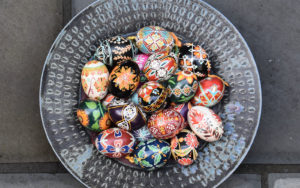
The photos of pysanky that appear on this page were designed by South Side-based artist Lisa DiStefano-Bauer. If you’d like to see more pysanky eggs, click here to see photos of the collection of Kathi Radock, who has purchased most of them from Saints Peter and Paul Church in Carnegie and other churches around the South Side, where she lives.
Saints Peter & Paul Church offers a number of instructive workshops around the Pittsburgh area every year in the weeks leading up to Easter. Typically, the church hosts a pysanky egg sale after Easter; this year the 53rd annual sale has been rescheduled to Saturday, June 6, promising “Easter in June.” In addition to more than 1,200 pysanky for sale, the event will feature different Ukrainian folk arts and crafts, tours of the church, and Ukrainian foods from the church’s kitchen: kielbasa, pyrohy/pierogie, holupchy/stuffed cabbage, homemade Easter paska bread, and other baked goods.
If you’re finding yourself craving Ukrainian baked goods before then, this Ukrainian Nut Torte recipe from Out of this Kitchen might do the trick. The recipe was submitted without attribution, but it was noted that this treat regularly appeared in the lunch pails that workers took to their mill jobs
Ukrainian Nut Torte
12 egg yolks
½ Tbsp. vanilla
2 ½ cups powdered sugar
1 lb. nuts (walnuts or pecans), ground
12 egg whites
1 Tbsp. fine bread crumbs
Beat egg yolks and vanilla until thick. Gradually add sugar and beat well until thick. Stir in the ground nuts. Fold in beaten egg whites alternately with bread crumbs. Bake at 320° for 1 hour.
Icing
2 whole eggs
1 egg yolk
Beat well together and add:
6 Tbsp. sugar
8 Tbsp. strong coffee
½ lb. unsalted butter
Combine whole eggs and egg yolk and beat well together. Add sugar and coffee. Put in double-boiler and stir until it thickens. Water should be hot, but not boiling. Do not overcook or it will curdle. Cool. Add butter and beat until creamy and smooth. Spread between layers and on top.
Slovakian
The recipe below is a different version of Easter cheese, called Cirek. The cook who submitted it to Out of this Kitchen, Adele Vamos of Munhall, had the following remembrance to share along with the recipe:
This recipe has a rather bland but sweet taste indicative of the moderation that Christians should have in all things. My childhood memories of Cirek include the many households in Whitaker with Cirek balls hanging outside on clotheslines at Easter time. When I saw my baba’s (grandmother’s) Cirek hanging out on the line or from the spigot in the bathtub, I knew we’d be taking the Easter basket to church for the traditional blessing of the baskets on Holy Saturday.”
Cirek | Easter Cheese
1 doz. Eggs, break yolks but do not beat
1-2 tsps. Vanilla
1 qt. milk
½ cup sugar
Combine all ingredients in a white enamel pan. Cook over medium to low heat, stirring constantly, until eggs curdle and form a heavy curd. Pour mixture into a colander that is lined with several layers of cheesecloth or a cotton dish towel. Once drained pick it up, cheesecloth and all, and twist the top part of the cloth tight until you’ve formed a ball. Tightly tie the open end with string, keeping the string very close to the top of the ball. Mixture will be very hot so be careful. Hang over the sink or on a clothesline until cool. Once it is cooled and formed, remove cheesecloth, wrap and refrigerate. Serve cold, sliced or cubed, with ham and Veal Loaf (pulnina). You must have extreme patience in making this dish. It takes about one hour to heat slowly and cook.
Kolachky
There are many ways to spell it: kolachki, kolachky, rohlicky, kolaczki, kolacky, kolache, or rozky. The prefix ko- or ro- comes from an ancient language base meaning roll, horn or stem. The recipe below was submitted by Margaret Majercik, who didn’t indicate what part of the Steel Valley she hailed from.
1 cup milk, scalded
½ cup sugar
1 cup shortening (½ butter, ½ margarine)
1 small yeast
4 cups flour
4 eggs
Combine first three ingredients and cool to lukewarm. Add yeast and stir well with wooden spoon. Add flour alternately with eggs. Stir well after each addition. Let rise for 6 hours in cool place, not refrigerator. Roll out about 1/2-inch thick. Cut into 3” squares and fill with favorite fillings, such as prune, cottage cheese, apricot, or canned pie fillings. Place on greased pans and let rise for 1 hour. Bake at 375° until brown, about 18-20 minutes. Brush with melted butter when removed from oven. Cool slightly and ice with powdered sugar icing or just sprinkle with powdered sugar when cool.
Italian
The recipe below is from Out of this Kitchen, and was submitted by Pat Sommers of Munhall. This simple soup would bring spring flavors to both Easter lunch and Passover Seder (when made with kosher ingredients).
Egg and Spinach Soup
4 cups broth
1 ½ lbs. fresh spinach, without stems
(Peas may be used instead of spinach)
4 eggs
½ cup grated Parmesan
Salt and pepper to taste
Bring broth to a boil and add spinach. Cook for 5 minutes. Beat eggs with 1 tbl. cheese. Pour into simmering soup. Simmer 1 minute. Top each serving with more cheese.
Polish
The Out of This Kitchen cookbook notes that Poles were one of the largest immigrant groups to settle in the Pittsburgh region in the late 1800s and early 1900s, and that a lot of those who came were families rather than individuals. “Not only were immigrants ready to lend a hand once you arrived in town, but they would send detailed letters to Poland chock-full of practical information for newcomers.”
The cookbook also points out that the Hyacinth is the traditional Polish Easter flower, and that Easter Monday is a holiday in Poland. “An old tradition, Smigus or Dyngus, consists of a splash of cold water waiting for them at every city corner or even a sprinkle in their old bed on Easter Monday.” The website Culture.PL explains that the day has come to be known as “Wet Monday.” The tradition likely goes back to the 14th century, but has pre-Christian origins connected to the March equinox and the coming of spring. Water is known as a symbol of life and renewal. Similar traditions can be found all around Central and Eastern Europe. Maybe you’ll start a water fight in your back yard with those you’re quarantined with?
Bialy Barszcz | White Borscht
This recipe was submitted to Out of This Kitchen by Sophie Lizik, and she notes that it is traditionally served at Easter.
2 qts. Water
1 cup diced boiled ham
½ lb. smoked kielbasa
2 tsps. Salt.
5 whole peppercorns
2 buds garlic
½ bay leaf
¾ cup sour cream
2 tsps. Sifted flour
Sour salt
Marjoram (optional)
Sliced hard-boiled eggs
Bring the water to a boil. Skin and thinly slice the kielbasa (Polish sausage). Add the ham, kielbasa, salt, peppercorns, garlic and bay leaf. Cook at a gentle boil for 30 to 40 minutes.
Using a fork, blend the sour cream and flour. Add the hot soup stock at the rate 1 tsp. at a time, stirring constantly, until you have about 2 cups of the mixture. Remove the soup stock from the heat and slowly add the sour cream and flour mixture.
If you do not have sour salt, use citric acid crystals or a concentrated citrus juice to make the soup tart to the taste. Add a pinch of marjoram, if you wish. The soup may be served over slices of hard-boiled eggs. The amount of egg is up to your taste, but a couple of slices will ordinarily suffice.
Want to learn more?
This recipe collection only scratches the surface of immigrant-inspired recipes for Easter and Passover. For even more ideas for the Seder Plate and meals throughout Passover, Chabad of Squirrel Hill has an extensive list of recipes and cooking tips listed by course. The Cinnamon and Coriander blog has a comprehensive list of traditional Easter recipes from around the world.
Local Business Options
- Chabad of Squirrel Hill offered Seder-to-Go kits, as well as funds for Pesach food and expenses. It also has an online form allowing Jews to authorize a rabbi to act as their agent in the sale of chametz (any food with leavening agents) to non-Jews. Information and a Passover guide can be found by clicking here.
- Jak’s Bakery is offering contact-free delivery of Bake-at-Home Banitsa, as well as classic and special Kozunak. Order online at jaksbakery.com or call 412-313-4190. Delivery dates available for both Catholic and Orthodox Easter. Jak’s Bakery specializes in Bulgarian breads and pastries, and is was opened in 2019 by Zhelyazko (Jak) Latinov, who owned and managed a bakery in his native Bulgaria for more than 18 years.
- Mantsch Blue Bonnet Bakery in Homestead is taking pre-paid pick-up orders, and will have paska bread, nut rolls, poppyseed rolls, apricot rolls, and more – including cakes shaped like bunnies, lambs, eggs, and Easter baskets. Call 412-462-4957 to place an order—pre-orders end soon.
- Jean-Marc Chatellier’s French Bakery in Millvale is taking pick-up orders for baguettes, macarons, pastries and more at 412-821-8533.
- BreadWorks in the North Side has curbside pickup of its Old World style breads available, including special Easter Packages. Order at breadworkspgh.com or call 412-231-7555, option 2.
- Carmi Soul Food in the Southside is open for takeout or delivery, promising that every bite tastes like home. Visit CarmiSoulFood.com or call 412-231-0100.
- Pink Box Bakery in Squirrel Hill is offering delivery service for its Taiwanese delicacies and desserts. Visit pinkboxpgh.com or call 412-422-2138.
- Café Kolache in Beaver is encouraging everyone to #KeepCalmAndKolacheOn by placing pick-up or delivery orders at cafekolache.com. Kolaches are savory or sweet, and made according to Czech tradition.
- The Enrico Biscotti Co.’s bakery in the Strip District remains open with curbside pick-up, local delivery and shipping options. Order online or call 412-281-2602.
- The Two Fraus Bakery in Harmony has Paska breads, chocolate-covered peanut-butter Easter eggs, hot cross buns, pretzels and more available – call 724-900-0392 or visit twofraus.com
- NEXT Pittsburgh has a full list of local chocolatiers who are offering personalized baskets, candy-making kits, spring crafts, and more with pick up and delivery options.
Guide to Images
Feature image: Image of a pysanky egg created and photographed by Lisa DiStefano-Bauer, 2020.
Image 2: Passover Sedar, 1964. Baraff Family, Fernwald Road, Sq. Hill, Pittsburgh, PA; L-R: Lisa Baraff, Barry Baraff, Sarah (Diamondstone) Baraff, Louis Baraff, Ethel (Gottesman) Baraff, Fritzi (Kronish) Gottesman, Ruth Anne Baraff
Image 3: Easter in Highland Park, Sprague Family, 1957. L-R: Marilyn (Sprague) McCoy, Joyce (Sprague) Anderson, Mark Sprague
Image 4: Bowl of pysanky eggs, created and photographed by South Side-based artist, Lisa DiStefano-Bauer, 2020.

 Traditions in a Time of Social Distancing
Traditions in a Time of Social Distancing